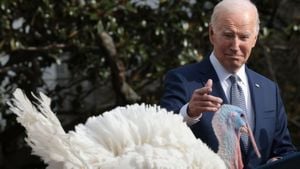Canadians are facing unprecedented prices at the grocery store as beef prices reach historic highs, reflecting both retail and ranch values. This surge, particularly noticeable during this busy time of year leading up to the holidays, has beef enthusiasts and everyday shoppers alike feeling the pinch. According to Statistics Canada, the average price of ground beef skyrocketed to about $13 per kilogram last September, compared to $11.69 the previous year and around $9 five years prior.
Jim Jackson, owner of Cut Rite Meats located in Calgary, shared his astonishment at the current prices, claiming it’s the highest he has witnessed during his years in the business. He notes, "I've been working here for quite a long time, and it's probably the all-time high I've ever seen." Jackson highlighted the fact—and perhaps the dilemma—that beef prices have been rising faster than those of pork and chicken. He mentioned how some customers have started to reduce the quantity they order due to the mounting costs. "Our profit at the end of the day is less. I don't want to gouge customers; we're just trying our best to navigate these waters," he explained.
Retail price fluctuations are usually common, but the steady upward trend has been evident over the last several years. The increasing prices are symptomatic of a larger issue, namely the value of cattle, which also hit record levels this year. Brenna Grant, executive director of Canfax, which is well-known for beef statistics, affirmed the market's climb, stating, "We are at record prices." The data suggests the overall food price index at grocery stores rose by 2.7 percent over the last year.
Among the beef cuts, striploin prices climbed past $32 per kilogram by September, significantly hiking from around $20 just nine months before. Grant pointed out, "Some feeder cattle are selling for 21 percent more compared to last year," and the average cattle prices have surged between 45 and 65 percent against the five-year average.
Several factors are fueling this price hike, starting with the global demand for beef, which has been increasing due to rising population numbers and growing middle-class demands for protein-rich food options. Grant mentioned, "We've got to keep in mind, globally, we have this growing population wanting more protein. It’s not just beef, but pork and poultry are also being affected by this demand pressure. Consumers are after more of these products, and this is impacting prices across the board."
On the supply side, conditions have become bleaker for ranchers. The cattle population has declined steadily, driven by several ranchers facing spiraling costs, particularly for feed. Bad weather exacerbated the situation this year, with severe drought conditions impacting fodder availability, complicate their ability to sustain herd sizes. Alarmingly, the number of cattle recorded has now fallen to its lowest since 1987.
Ellen Goddard, emeritus professor and agricultural economist at the University of Alberta, elaborated on the challenges facing beef production. She said, "Beef is a complicated commodity because nobody can turn on beef supply quickly. Cow-calf producers on the Prairies decide how many cows they'll keep, and this decision dictates how many calves are born, affecting beef supply about two and half years later." This timeline highlights the long biological lag involved with beef production.
Consequently, the reduced number of cattle translates directly to diminished availability of beef for consumers at retail locations. Market analyst Kevin Grier shared insights on the current state of the beef industry, saying, "The industry is in full-fledged liquidation mode right now. It's not surprising to see lower supplies resulting in higher prices." Demand from consumers remains strong, which Grier noted, is evident by Canadian and American customers continuing to purchase high amounts of beef even at these unprecedented prices. "We've got at least another year, perhaps moving even to 2026, of very tight beef supply," he added.
Despite prices hitting new heights, cuts of beef continue to attract buyers who perceive them as the highest quality meat available. Goddard remarked, "Beef is the Cadillac of meats," emphasizing its premium position within food preferences.
Overall, the skyrocketing beef prices represent not just market numbers but deeply intertwined issues of global demand, supply constraints, and local consumer choices. The combination of all these factors ensures high prices remain for the foreseeable future, reigniting conversations around meat consumption and sustainability within the agricultural sector. With beef remaining firmly on the plates of many Canadians, how the industry adapts to these economic pressures will be closely watched.



